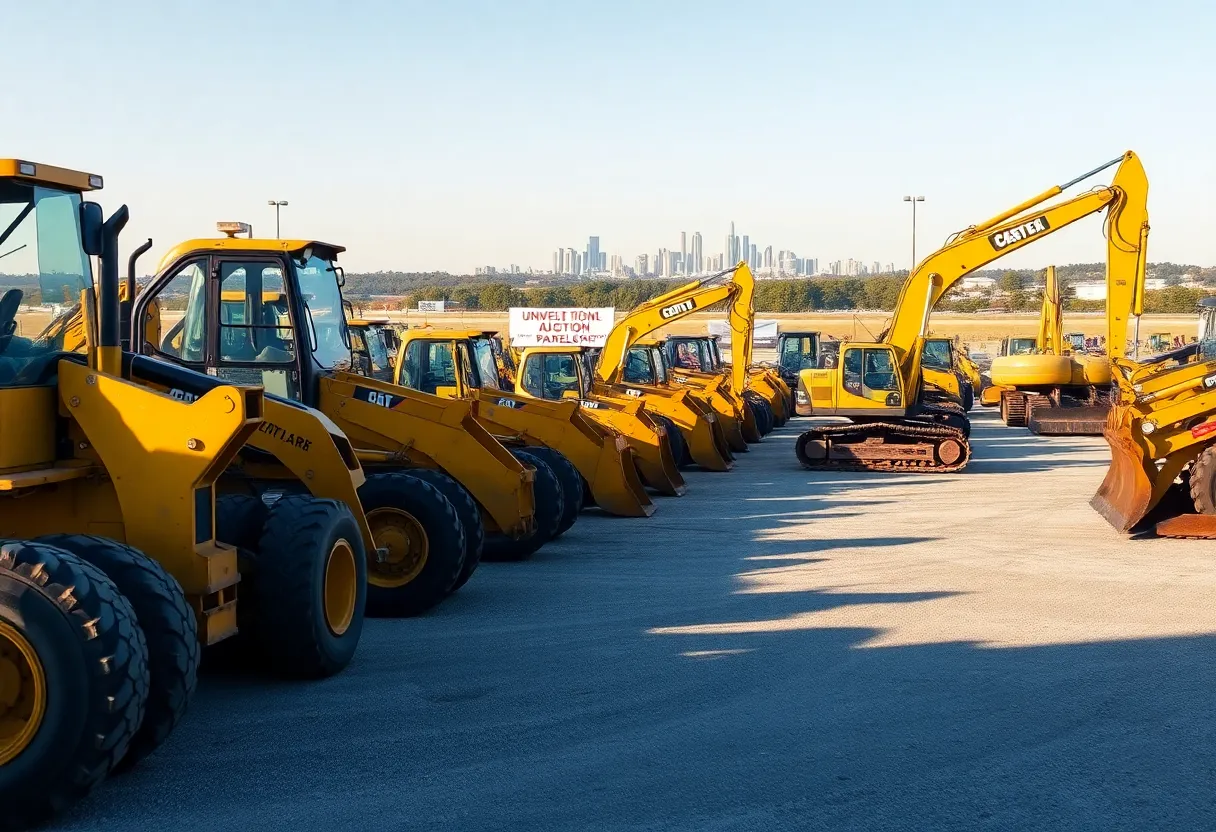Ann Arbor, Michigan, August 19, 2025
News Summary
Strong summer demand is shifting medium- and heavy-duty used construction equipment into rental fleets rather than dealer sales floors, prompting dealers to expand inventories and lenders to increase financing activity for projects of all sizes. Market values stayed largely stable in July, though dealers worry about a potential year-end glut when rental returns could flood lots and push more assets to auctions. Lenders report steady loan pipelines—from single-operator tools to heavy infrastructure machines—including recent multi-million-dollar deals. In Ann Arbor, rising home and rent pressures coincide with a new Green Rental Housing Ordinance requiring Asset Ratings and a proposed municipal rental portal.
Used construction machines stay on rental fleets as summer boom fuels lender interest; Ann Arbor wrestles with costly housing and a new green rental rule
Used construction equipment is moving less through dealer sales and more through rental fleets this summer, while lenders are stepping up to finance used machines for big projects. At the same time, Ann Arbor is facing rising housing costs and a new Green Rental Housing Ordinance that could reshape how landlords operate and what renters pay.
Top lines: rentals, lenders and rising housing pressure
Strong summer construction activity is prompting dealers to keep medium- and heavy-duty used equipment in rental service rather than sell it. The rental approach helps contractors meet short-term needs but raises the risk of a year-end flood of returns. Lenders report steady applications across equipment types, including larger-ticket items, and some lenders are closing million-dollar loans for single operators. Meanwhile, local leaders in Ann Arbor are pursuing a city-run renter website and a new green standard for rental properties as residents report difficulty affording housing.
Why dealers are favoring rentals now
Dealers are responding to a summer spike in short-term contractor demand by expanding rental fleets. Keeping machines in rentals delays used-equipment inventory hitting dealer lots, which supports current values and keeps retail sales from being the only outlet. Dealers are also preparing contingency plans for a possible surge in returned rentals at the end of the year; one commonly cited strategy is to move excess inventory through auctions where buyers can pick from many running machines in a single event.
Market prices and recent data
Recent market data dated Aug. 6 show that used construction equipment prices stabilized in July, with asking and auction values changing only marginally from June. That stability follows months of volatility and reflects the mix of continued construction demand and growing rental fleets that limit fresh resale supply.
Lenders see opportunity despite rental competition
Finance professionals report a steady application flow for a wide range of equipment. Lenders are finding opportunities not only in smaller rentals and single-operator purchases but also in large infrastructure projects that require used scrapers, wheel loaders and other heavy machines. One lender completed a $1.45 million loan for a family-owned operation recently, illustrating that larger tickets are still financeable when projects are ready to move.
Infrastructure work is a key driver
Public road and infrastructure programs are helping keep used heavy equipment in demand. In regions where road repairs are being accelerated, financiers and vendors report seeing scrapers and loaders at active sites, and shovel-ready projects are translating into steady, practical needs for used machines.
Risks and secondary effects
While rentals help meet short-term contractor needs, they may cut into retail sales for dealers and create inventory spikes when contracts end. Auctions are likely to be the quickest way to absorb a year-end influx of used machines, but large auction supply could pressure prices if too much equipment hits the market at once.
Ann Arbor: steep rents, council solutions and a new green ordinance
Ann Arbor residents and officials report growing worry about housing affordability. Average home values in the area are high, and even vacant lots sell for substantial sums. One-bedroom rents that were once considered expensive are now being positioned as relatively affordable compared with newer, costlier developments.
Voices from the rental market
Several renters describe strain: one recent arrival negotiated a one-bedroom rent down to about $1,500 from a much higher initial asking price; other residents share homes to keep per-person costs near or just above $1,000; some students and young renters report fluctuating rents from year to year. These individual cases underline why city leaders are discussing more tools to help renters find options and understand rights.
City action: a renter website and data goals
City council members are considering a municipal website to aggregate rental listings and highlight smaller landlords. The goal is to make it easier for renters to find listings, learn tenant rights and report issues. Data collected from the site would also inform city reports on who is finding housing and which groups may be underserved.
Green Rental Housing Ordinance
The newly approved green rental rule requires landlords to meet a qualifying energy performance level before routine rental inspections. Compliance paths include a prescriptive checklist or a third-party energy rating. Failure to meet standards could block rental license renewal and may lead to civil fines and legal costs. Supporters say the ordinance will improve tenant comfort and lower long-term bills; critics warn that upfront retrofit costs could push rents higher and shrink rental options for low-income residents and students.
Where these threads meet
Both the equipment market and the local housing debate illustrate how public investment and regulation shape private markets. Infrastructure spending is keeping used heavy equipment in demand and attracting lender capital, while local housing rules and rising property values are changing the rental landscape in ways that matter to residents and landlords alike.
FAQ
Why are dealers keeping used construction equipment in rentals?
Dealers are meeting strong short-term contractor demand and protecting resale values by placing medium- and heavy-duty machines into rental service rather than selling them immediately.
Will there be too much used equipment for sale later in the year?
A potential year-end glut of rental returns is a concern. Many dealers and financiers plan to use auctions to move excess inventory quickly, though large auction volumes could pressure prices.
Are lenders still financing used heavy equipment?
Yes. Lenders report steady application flow across equipment sizes and are financing larger-ticket used machines, especially when infrastructure projects are ready to proceed.
What is the Green Rental Housing Ordinance in Ann Arbor?
The ordinance requires rental properties to meet an energy performance standard before routine inspections, with compliance options and penalties for noncompliance. It aims to improve tenant comfort and lower operating costs but may increase upfront costs for landlords.
How might the ordinance affect rents and rental availability?
Supporters expect long-term tenant savings and better living conditions, while critics warn that retrofit costs could be passed to tenants and reduce available rental units, particularly for lower-income renters and students.
Key features at a glance
| Topic | Main point | Near-term impact |
|---|---|---|
| Equipment rentals | Dealers expand rental fleets to meet summer demand | Fewer used units for sale; possible year-end inventory spike |
| Lender activity | Steady applications; financing for large used machines continues | More capital for infrastructure-linked purchases |
| Market pricing | July values largely stabilized month-to-month | Short-term price stability despite rental growth |
| Ann Arbor housing | High home values and tight rental market | Residents seek tools and protections; policy changes pending |
| Green rental rule | Energy performance required for rental licensing | Potential long-term tenant savings; possible short-term rent increases |
Deeper Dive: News & Info About This Topic
Additional Resources
- MLive: Some of the highest rent — Ann Arbor’s lack of affordability under scrutiny
- Wikipedia: Housing affordability
- The Michigan Daily: Ann Arbor City Council passes Green Rental Housing Ordinance
- Google Search: Ann Arbor Green Rental Housing Ordinance
- WXYZ: City of Ann Arbor to launch website that helps renters find more housing options
- Google Scholar: municipal rental portal
- MLive: Landlords warn rents may rise as Ann Arbor OKs green rental housing law
- Encyclopedia Britannica: Rental housing
- Michigan Capitol Confidential: Ann Arbor mulls green energy mandates as housing costs soar
- Google News: Ann Arbor green energy mandates housing costs





